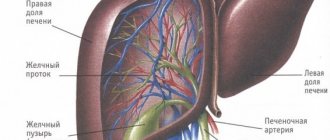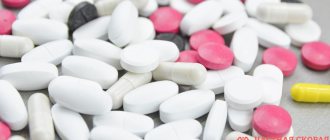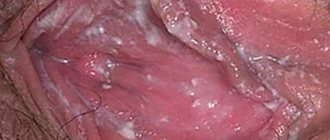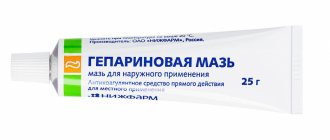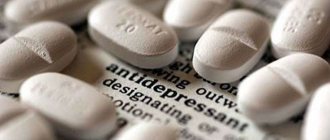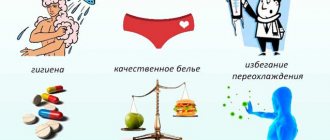The role of the liver in the body
Role of the liver
Since ancient times, people have called the liver “the source of life” and knew that it is the most important organ in the human body. Now scientists and doctors have a complete picture of how this gland works, what it secretes and why it can suffer. Thanks to this, we are able to maintain the liver in good condition for many decades.
The liver is considered the largest gland in the human body. It is located on the right side of the abdominal cavity under the intercostal space.
The main functions of the liver are metabolism, neutralizing toxins, maintaining metabolism. The approximate weight of a healthy liver is about 1700
grams It consists of large lobes, divided into smaller lobules, shaped like a multifaceted prism. Liver cells are responsible for neutralizing toxic substances and producing bile. In the liver, proteins are broken down into amino acids, and excess glucose is converted into a storage substance - glycogen. It’s not for nothing that the liver is called a “fat depot” - it is responsible for fat metabolism. In addition, the liver metabolizes vitamins and hormones.
The liver breaks down poisons, toxins and substances that can cause allergies to more harmless substances. Excess vitamins in the body also pass through the liver and are broken down there. On average, in one hour this organ is capable of passing about 90 liters of blood through itself!
Causes of development of pathologies The most dangerous factors in the development of liver pathologies:
- alcohol abuse; - excessive consumption of fatty, fried foods;
With alcoholic liver poisoning, a person becomes lethargic, quickly fatigues and irritability. Afterwards the symptoms only get worse. Jaundice, tachycardia (rapid heartbeat) and other symptoms appear. The worst thing is that in the early stages of alcoholic liver disease there is no pain, since this organ has no nerve endings.
An unhealthy diet with plenty of fatty and fried foods, coupled with a lack of physical activity, has a detrimental effect on liver health. The liver does not have time to process the large amount of fat entering the body and fat begins to be deposited in the liver cells, thereby provoking their degeneration. Which can later lead to cirrhosis or even liver cancer.
The use of medications also negatively affects the liver; it, like a sponge, absorbs all harmful elements, preventing them from entering other organs with the blood. You need to be especially careful when buying medications without a doctor’s prescription - they can cause a serious blow, the consequences of which you are not even aware of. To avoid the harmful effects of medications, you must follow their dosage and take only medications prescribed by your doctor.
The liver can also be affected by viral hepatitis. This is the most dangerous disease that can be fatal (depending on the type of virus). General symptoms: chills, jaundice, general malaise. Pain in the right side of the hypochondrium. More than 30% of Russian residents with liver disease have risk factors for alcohol-related damage to this organ.
The main types of pathological changes in the liver are: hepatosis (fatty liver, steatosis) hepatitis; fibrosis cirrhosis; liver failure; cancer and others. Symptoms of liver dysfunction are often similar to symptoms of diseases of other organs, so it can be difficult to make a final diagnosis.
Common symptoms include: - general malaise; - weak appetite and changes in stool; - irritability associated with poor removal of toxic substances from the body, which adversely affect the brain; — lethargy and frequent colds due to weakened immunity; - skin itching and allergic reactions; - feeling of heaviness in the stomach; - pain in the area of the legal hypochondrium; - nausea and a feeling of bitterness in the mouth.
The most important symptom unique to liver diseases is jaundice.
Jaundice is the yellowing of the skin and whites of the eyes. It is directly related to increased bilirubin levels in the blood. Early diagnosis of the disease will help the doctor prescribe effective treatment for you, so the sooner you seek medical help, the better for you and your liver.
A gastroenterologist treats liver pathologies. Prevention of liver disease is to follow a diet, eliminating fatty and fried foods from the diet. Complete absence of alcohol (even in small quantities!). Portions should be small and meals should be frequent (about 4-5 times a day) so as not to put a lot of stress on the liver.
Take care of yourself and your liver!
Cholesterol metabolism
Cholesterol molecules form the structural framework of all cell membranes without exception. Cell division is simply impossible without sufficient cholesterol. Bile acids are formed from cholesterol, i.e. essentially bile itself. All steroid hormones are formed from cholesterol: glucocorticoids, mineralocorticoids, and all sex hormones. Cholesterol synthesis is therefore genetically determined. Cholesterol can be synthesized in many organs, but it is most intensively synthesized in the liver. By the way, the breakdown of cholesterol also occurs in the liver. Some of the cholesterol is excreted unchanged into the intestinal lumen with bile, but most of the cholesterol - 75% is converted into bile acids. The formation of bile acids is the main pathway of cholesterol catabolism in the liver. For comparison, let's say that only 3% of cholesterol is consumed for all steroid hormones taken together. A person excretes 1-1.5 g of cholesterol per day with bile acids. 1/5 of this amount is excreted from the intestines, and the rest is reabsorbed into the intestines and ends up in the liver.
Causes
Pain in the right hypochondrium can signal a number of pathologies. These could be problems with the pancreas, gallbladder or bile ducts. When the liver is significantly enlarged, pain is caused by the membrane surrounding the organ.
In order not to let the situation become critical, be sure to make an appointment with a doctor if you experience any unusual or uncomfortable sensations in your right side.
Our clinic employs true professionals who will quickly diagnose and prescribe appropriate treatment.
To eliminate pain in the right hypochondrium, it is necessary to establish the exact cause of its occurrence. It can be caused by:
- gastritis in the period of exacerbation, pancreatitis (irradiation of pain)
- stones in the area of the bile ducts or gallbladder, as well as in the inflammatory process of the gallbladder - cholecystitis
- inflammatory liver diseases (in particular, hepatitis) Hepatitis is of two types: infectious and toxic. Causes: infection with viruses A, B and C. Main symptoms: dull pain, yellowness of the skin or sclera of the eyes, weakness, nausea, and less often - itching.
- liver cirrhosis One of the most severe diseases. There is a proliferation of connective tissues and the development of inflammatory processes, impaired circulation both in the organ itself and in neighboring ones. Causes of occurrence: in more than 50% of cases, it is alcohol consumption. Main symptoms: in the initial stages they are very similar to manifestations of hepatitis. Diagnosis is made using ultrasound or biopsy.
- irritable bowel syndrome
- malignant neoplasms (including secondary metastatic liver disease)
- closed injuries As a rule, they arise as a result of a blunt blow to the abdominal area.
Pain can be caused by:
- physical activity (even minor),
- eating fatty, spicy or fried foods (usually accompanied by nausea),
- bad habits (smoking, alcohol).
Treatment
To temporarily relieve pain in the liver, patients take painkillers and antispasmodics on their own. Always remember that they can only be used after examination and recommendations from a specialist. Treatment is prescribed only after thorough diagnostic studies. Since many liver diseases have a similar course, it is necessary to make a correct diagnosis.
Before visiting a doctor, do not take painkillers or antispasmodics. They will mask important symptoms and make it difficult to make a diagnosis during examination.
Under no circumstances should you select medications yourself. And especially do not take medications prescribed to your friends in similar situations. There is no guarantee that the drugs that help them won't make things worse for you. Treatment is selected strictly individually.
To deal with this situation, consult a doctor as soon as possible. Our center is equipped with modern research equipment. This helps specialists make an accurate diagnosis and prescribe effective treatment as soon as possible.
Before visiting a doctor to relieve pain symptoms (instead of taking medications), pay attention to your diet. You can independently reduce the load on the organ.
The diet to eliminate pain in the liver should be gentle and low in fat.
- It is recommended to eat: black bread, low-fat dairy products, various cereals, vegetables and fruits, boiled meat and poultry (beef, chicken).
- it is necessary to completely exclude: fried, spicy smoked, and fatty foods, baked goods, mushrooms, pork, duck, canned food, confectionery, coffee.
In some cases, diet helps much more effectively than drug therapy.
The best diagnosis of pain in the liver is MRI of the liver and MRI of the gallbladder. To identify health problems in the early stages, doctors recommend periodically undergoing a full comprehensive examination of the body.
The contents of this article have been checked and confirmed for compliance with medical standards by a gastroenterologist of the highest qualification. category Grankova Tatyana Mikhailovna.
Excretory (excretory) function
The excretory function of the liver is very closely related to bile formation, since substances excreted by the liver are excreted through bile and, if only for this reason, they automatically become an integral part of bile. Such substances include the thyroid hormones already described above, steroid compounds, cholesterol, copper and other trace elements, vitamins, porphyrin compounds (pigments), etc.
Substances excreted almost exclusively with bile are divided into two groups:
- Substances bound to proteins in the blood plasma (for example, hormones).
- Substances insoluble in water (cholesterol, steroid compounds).
One of the features of the excretory function of bile is that it is capable of introducing substances from the body that cannot be removed from the body in any other way. There are few free compounds in the blood. Most of the same hormones are tightly bound to transport proteins in the blood and, being firmly bound to the proteins, cannot overcome the kidney filter. Such substances are excreted from the body along with bile. Another large group of substances that cannot be excreted in urine are substances that are insoluble in water. The role of the liver in this case is that it combines these substances with glucuronic acid and thus converts them into a water-soluble state, after which they are freely excreted through the kidneys. There are other mechanisms that allow the liver to remove water-insoluble compounds from the body.
The meaning of the gland
The liver is responsible for purifying the blood, most of the blood flow is sent to the arteries and veins of the digestive organs, the rest serves as the basis for the supply of oxygen. The functions of the organ are filtration, restoration of standard indicators of protein and carbohydrates.
The gland answers:
- for the production of plasma proteins;
- cleansing the bloodstream of toxins;
- metabolism of ammonia to urea;
- thermoregulation;
- production of bile secretion;
- synthesis of digestive hormones, enzymes;
- normalization of lipid and carbohydrate metabolism, production of nutrients, etc.
The organ allows you to neutralize and remove harmful or excess exogenous and endogenous substances from the body.
Neutralizing function
The liver plays a protective role not only by neutralizing and removing toxic compounds, but even by microbes that get into it, which it destroys. Special liver cells (Kupffer cells), like amoebas, capture foreign bacteria and digest them. In the process of evolution, the liver has become an ideal organ for neutralizing toxic substances. If it cannot turn a toxic substance completely non-toxic, it makes it less toxic. We already know that toxic ammonia is converted into non-toxic urea (urea) in the liver. Most often, the liver neutralizes toxic compounds by forming paired compounds with them with glucuranic and sulfuric acid, glycine, taurine, cysteine, etc. This is how highly toxic phenols are neutralized, steroids and other substances are neutralized. A major role in neutralization is played by oxidative and reduction processes, acetylation, methylation (which is why vitamins containing free methyl radicals-CH3 are so useful for the liver), hydrolysis, etc. For the liver to perform its detoxification function, sufficient energy supply is necessary, and for this, in in turn, it requires a sufficient glycogen content and the presence of a sufficient amount of ATP.
Blood clotting
The liver synthesizes substances necessary for blood clotting, components of the prothrombin complex (factors II, VII, IX, X), the synthesis of which requires vitamin K. The liver also produces fibranogen (a protein necessary for blood clotting), factors V, XI, XII , XIII. Strange as it may seem at first glance, the liver synthesizes elements of the anticoagulant system - heparin (a substance that prevents blood clotting), antithrombin (a substance that prevents the formation of blood clots), and antiplasmin. In embryos (fetuses), the liver also serves as a hematopoietic organ where red blood cells are formed. With the birth of a person, these functions are taken over by the bone marrow.
Where is the liver located
The organ is visually similar to a mushroom cap and is located on the right side of the abdominal cavity. The upper section of the liver is localized in the area of the 4th-5th rib, the lower – in the area of the tenth. The front part of the organ is located near the 6th rib.
The upper, diaphragmatic face has a concave shape, and the lower, visceral face has three longitudinal grooves. The sections are separated from each other by a lower sharp edge. The average weight of the liver is 1.5 kg, and it always has high temperatures. The organ has regenerative abilities; if its work stops, the body can live no more than a few days.
Vitamins
All fat-soluble vitamins (A, D, E, K, etc.) are absorbed into the intestinal walls only in the presence of bile acids secreted by the liver. Some vitamins (A, B1, P, E, K, PP, etc.) are deposited by the liver. Many of them are involved in chemical reactions occurring in the liver (B1, B2, B5, B12, C, K, etc.). Some vitamins are activated in the liver, undergoing phosphorication there (B1, B2, B6, choline, etc.). Without phosphorus residues, these vitamins are completely inactive and often the normal vitamin balance in the body depends more on the normal state of the liver than on the sufficient intake of one or another vitamin in the body. As we can see, both fat-soluble and water-soluble vitamins can be deposited in the liver; only the time of deposition of fat-soluble vitamins, of course, is disproportionately longer than that of water-soluble vitamins.
